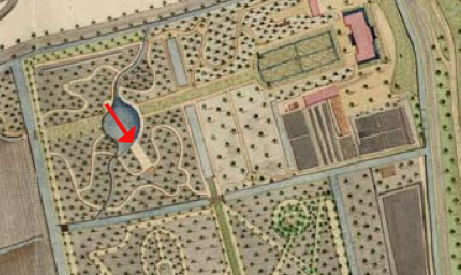The use of evergreens is widespread in the history of gardening. But the way they are represented on maps is not always clear. Or rather, they are not always shown on maps, while we know from other contemporary sources that they were there.
Two Dutch examples:
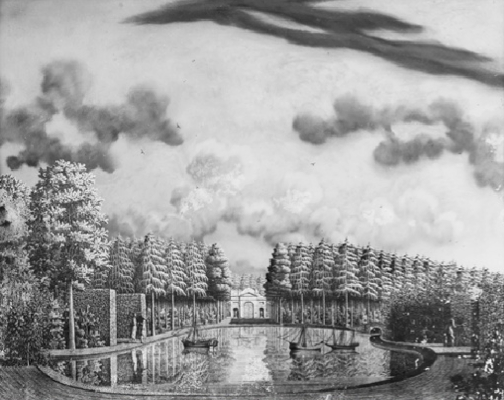
One example is the garden of Huys ten Donck, where we know from a glass painting (or ‘verre eglomisé‘) by Jonas Zeuner that one of the ponds was bordered by a small forest of evergreens. The painting is dated ca 1781, as is the map of Huys ten Donck by two surveyors called Maan en Harte. But here we see no clear indication of the evergreens being planted there. Did we not have the garden view by Zeuner, we wouldn’t have had a clue.
Huys ten Donck, detail of a map by Cornelis Willem Maan and Pieter Harte, ca 1781. The red arrow indicates the line of view of the Zeuner painting.
The same goes for the garden of the Dutch physician Nicolaas Bidloo, created along the borders of the Yauza (or Jauza) river near Moscow in the first decades of the 18th century. Bidloo himself drew the garden plan, birds-eye view and views within the garden, probably between 1725 and 1730. The whole setup seems to indicate that he wanted these drawings to be published, but that never happened. 1See David Willemse (introd.), The unknown drawings of Nicholas Bidloo, Director of the first hospital in Russia, Voorburg (1975).
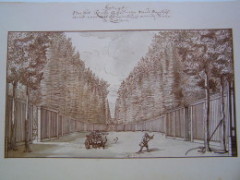
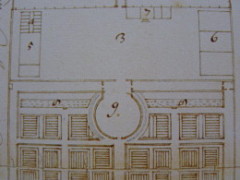 One of the garden views (above left) shows a circular space, marked with the number 9, surrounded by a fence and evergreens. When we look at the garden plan (above right), we see the same circular area with the same number 9, but no indication whatsoever that it is surrounded by trees, let alone by evergreens.
One of the garden views (above left) shows a circular space, marked with the number 9, surrounded by a fence and evergreens. When we look at the garden plan (above right), we see the same circular area with the same number 9, but no indication whatsoever that it is surrounded by trees, let alone by evergreens.
The strange thing is that in this case even the birds-eye view (below -click the image for a larger view) does not show there are evergreens planted here. The only thing confirming the garden view, is the legend on the right side of the garden plan, where it says under number 9: “A circular space surrounded by a beautiful fence, and very high pine and lime trees. A thick forest one can walk around.” 2“9. Een Rond, omzet met een moij hek, en grote denne & linde bomen. Een digt bosch dat men rondom gaan kan.”
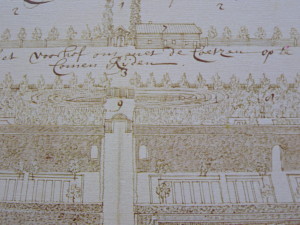
So the only evidence of what this part of the Bidloo garden looked like, comes from the garden drawing, and the legend on the garden plan. Both these features are rare, very rare. In any case they are much less available than the maps and garden plans we garden historians usually have at our disposal, and on which we base many of our conclusions about the actual layout and contents of a garden.
In the case of both Bidloo‘s garden near Moscow and the garden of Huys ten Donck, we would not have known about these evergreens if we only had the garden plans at hand. It begs the question how many evergreen plantations we have inadvertedly overlooked in our investigations…

